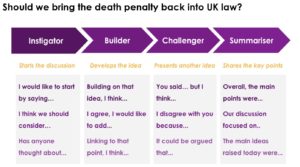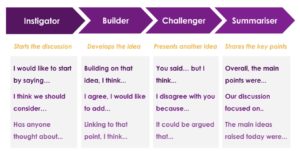01.18.22“Rolling Out” Habits of Discussion with Ipswich Academy’s Ben Hall

Ben’s Habits of Discussion ‘roll out’ slide.
A week or so ago I shared on Twitter a really great slide that Ipswich Academy (Ipswich, England) uses to support teachers in helping them implement one of the most important but challenging techniques in the TLAC toolbox.
The technique–Habits of Discussion–involves building a set of habits and norms that cause students to listen actively and talk to (rather than past) each other.
In Habits of Discussion students reference preceding comments and build off of them, typical using phrases like:
- “I understand why you’d say that, but …”
- “I’d like to share another example of that …”
- “Something that argument may not take into account is …”
- “I want to build on what you said …”
In each of these examples students begin by framing a relationship between their present comment and the previous one. In so doing they shows respect for previous speakers and weave their comments together with their classmates to form more cohesive discussions.
It’s beautiful when done well but not always easy to installing such norms. That’s why the slide I shared was popular. It laid out for students (and teachers) exactly what the norms were in a collaborative discussion.
Here it is:

That’s GOOD…. but GREAT would be a video showing a teacher using this template to introduce and instill the key habits. So I am very happy to tell you I have just such a video.
Here, in a video worth its weight in gold, is Ben Hall of Ipswich Academy using Habits of Discussion for the first time with his students.
Some key points:
Notice the moves Ben employs before he even begins the class discussion: first students review their notes so facts and research are in their working memory. Next they Turn and Talk to rehearse and share ideas. Now everyone is likely to have something to say.
Next Ben explains the different roles students can play in discussion. The process is transparent to them: someone will open. He’ll ask others to support or challenge. He’ll Cold Call so everyone should be ready to weigh in. They should be listening carefully because a few people will be asked to summarize.
Ben also points out the sentence starters that are so useful in helping students learn to connect their ideas. They’re visible to students throughout and perhaps for this reason they use them consistently.
Actually they use and adapt them. That’s one of the great things about sentence starters like these. Students may begin copying them but over time they learn to adapt and apply them in unique ways.
The discussion ends on a high point, at least for me personally. Katie, asked to summarize, dos a heroic job. She starts by saying “most people think” but corrects that. “A lot of people think…” she says, “…but some people also say….” The discussion has made her keenly aware that the room is divided and she tempers her characterization and ably describes both opinions.
Thanks to Ben and his students for modelling how Habits of Discussion can be “rolled out” with a clear model so students experience initial success and form a foundation of listening and speaking skills that will grow and develop throughout the year!
